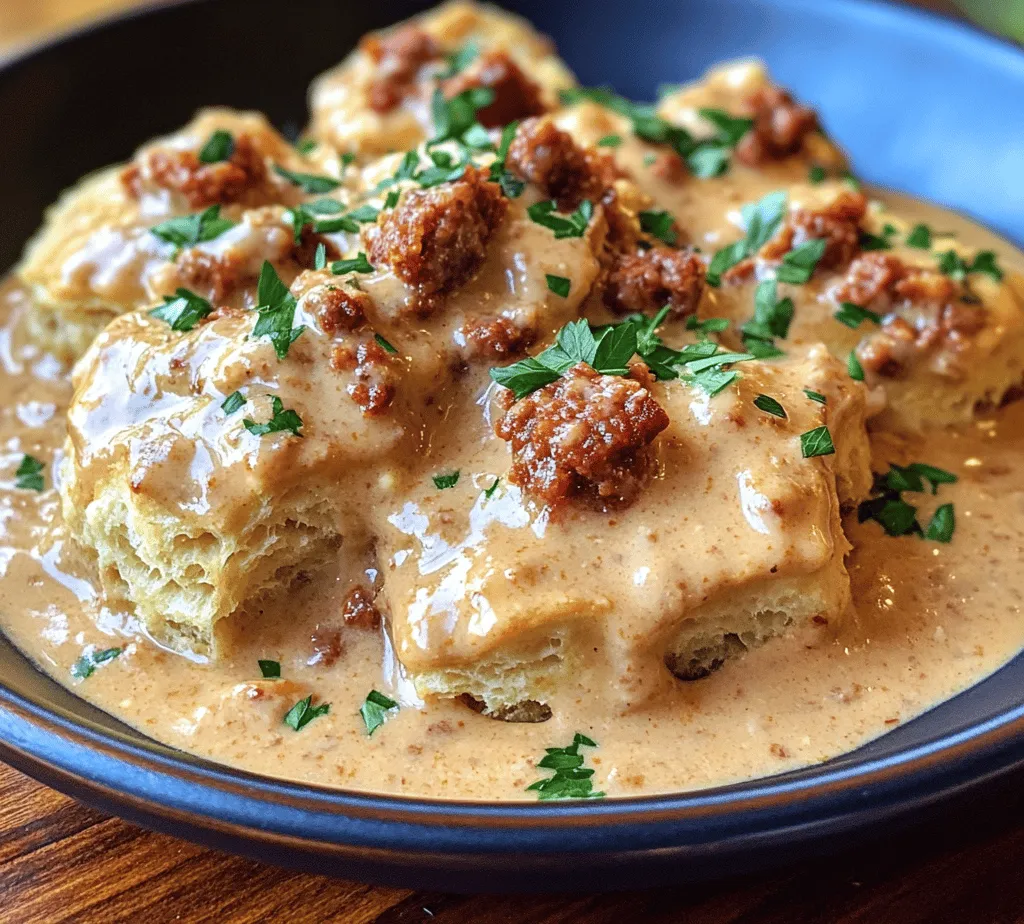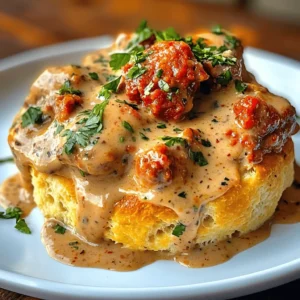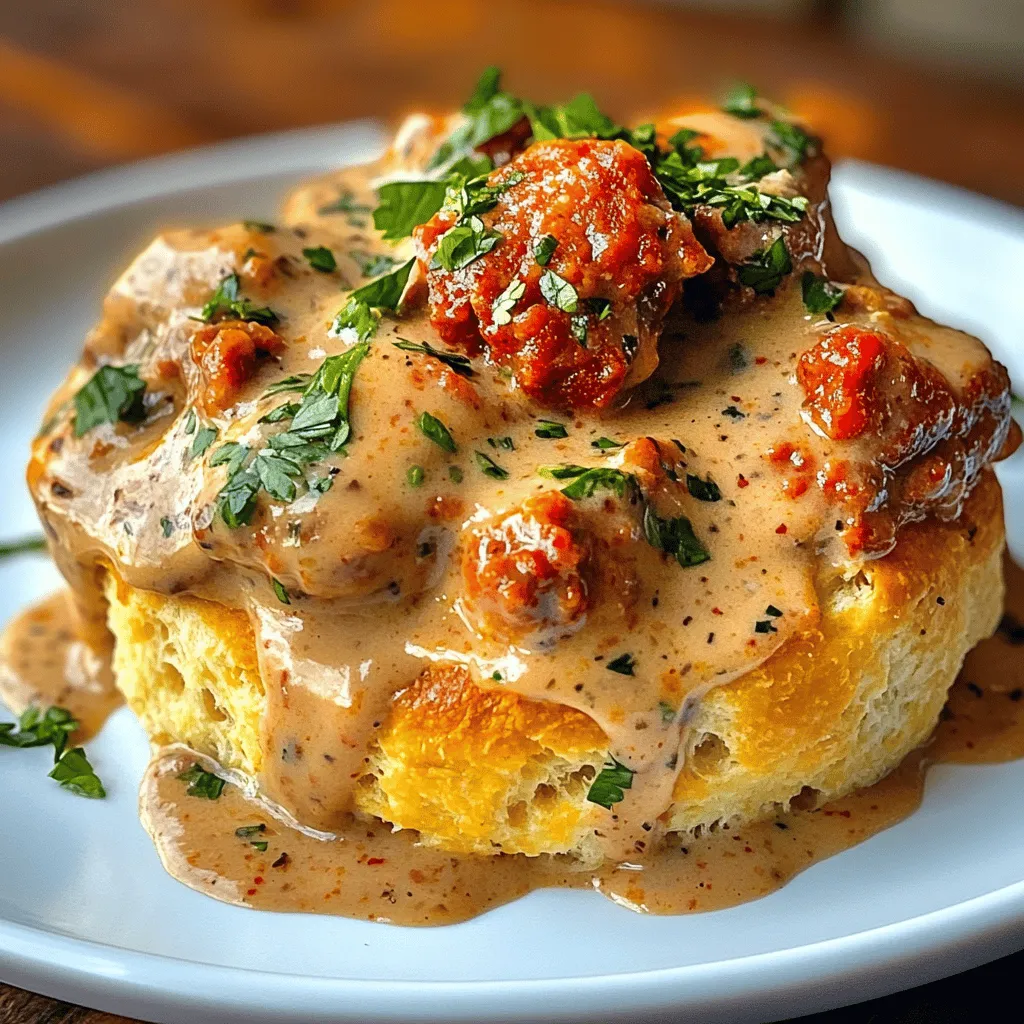Introduction
Welcome to a journey through Southern cuisine, where comfort food reigns supreme. Today, we invite you to indulge in a classic dish that embodies the essence of Southern hospitality: Biscuits and Chorizo Gravy. This recipe combines the light, fluffy texture of freshly made biscuits with a rich, spicy gravy featuring chorizo, a flavorful sausage that adds a kick to the traditional recipe. Whether you’re preparing a family breakfast or hosting a weekend brunch with friends, this dish promises to bring warmth and satisfaction to your table.
Originating from the Southern United States, biscuits and gravy is a staple breakfast item that has been enjoyed for generations. Originally made with simple ingredients and designed to feed large families, this dish showcases the resourcefulness of Southern cooks who knew how to create something hearty and delicious without breaking the bank. By integrating chorizo, this version elevates the classic recipe, infusing it with bold flavors that excite the palate.
In this article, we will guide you through the process of making this delightful dish, breaking it down into detailed steps, and exploring the key ingredients that make this meal truly special. From the preparation of the biscuits to the creation of the savory chorizo gravy, you’ll learn how to create a dish that is not only satisfying but also steeped in rich culinary tradition.
Understanding the Key Ingredients
To create the perfect Biscuits and Chorizo Gravy, understanding the key ingredients is essential. Each component plays a crucial role in achieving the desired flavors and textures, and knowing their characteristics will help you elevate your cooking skills.
The Role of All-Purpose Flour in Biscuit Making
All-purpose flour is the foundation of any biscuit recipe. It provides the structure necessary for the biscuits to rise and maintain their shape. When selecting flour, it’s important to consider its texture and protein content. Higher protein flours can create a denser biscuit, while lower protein varieties yield a softer crumb.
The texture of the flour affects how the biscuits rise. During baking, the flour’s proteins interact with moisture and heat, forming gluten, which gives the biscuits their structure. However, overworking the dough can lead to tough biscuits, so it’s crucial to handle the mixture gently.
The Significance of Baking Powder and Baking Soda
Baking powder and baking soda are both leavening agents used in biscuit recipes. They play a vital role in creating the light and fluffy texture that we associate with perfect biscuits.
Baking powder contains a combination of baking soda, cream of tartar, and a moisture absorber. It releases carbon dioxide when it comes into contact with liquid, creating bubbles that help the biscuits rise. On the other hand, baking soda requires an acidic ingredient, like buttermilk, to activate its leavening properties. Understanding how to balance these two ingredients is key to achieving optimal fluffiness in your biscuits.
The Importance of Cold Butter in Baking
When it comes to biscuit making, the temperature of the butter is crucial. Cold butter is essential for achieving a flaky texture. As the cold butter melts during baking, it creates steam, which helps to separate the layers of the biscuit dough, resulting in that desirable flakiness.
To incorporate cold butter into your dough correctly, it’s best to cut it into small cubes before adding it to the dry ingredients. You can use a pastry cutter or your fingertips to work the butter into the flour until the mixture resembles coarse crumbs. This technique ensures that the butter remains cold, contributing to the perfect biscuit texture.
Buttermilk: A Key Ingredient for Flavor and Tenderness
Buttermilk is another pivotal ingredient in biscuit making. It not only adds a tangy flavor but also interacts with the baking soda to create a tender biscuit. The acidity of buttermilk helps to break down gluten, resulting in a softer texture.
When using buttermilk in your biscuits, ensure that it is fresh for the best flavor. If you don’t have buttermilk on hand, you can create a substitute by combining regular milk with a splash of vinegar or lemon juice, allowing it to sit for a few minutes before use.
Exploring Chorizo: Types and Flavor Profiles
Chorizo is a spicy sausage that brings a robust flavor to the gravy. There are two primary types of chorizo: fresh and dried. Fresh chorizo is raw and must be cooked before consumption, while dried chorizo is cured and can be eaten without cooking.
For this recipe, fresh chorizo is the preferred choice as it crumbles easily and infuses the gravy with its rich, spicy flavor. The unique spices that define chorizo include paprika, garlic, and cumin, which contribute to its distinct taste. When selecting chorizo, opt for high-quality sausage to ensure the best flavor in your dish.
The Role of Garlic and Onion Powder in Gravy
Garlic and onion powder are essential seasonings that enhance the flavor of the chorizo gravy without overwhelming it. They provide a savory depth that complements the spiciness of the chorizo.
While powdered versions are convenient, consider using fresh garlic and onions for a more vibrant flavor. Sautéing fresh onions and garlic in the pan before adding the chorizo will create a rich aroma and a more complex flavor profile. However, keep in mind that the key is to find a balance so that the gravy remains a harmonious blend of flavors.
Step-by-Step Instructions for Making Biscuits
Now that we understand the importance of the key ingredients, let’s dive into the step-by-step instructions for making the biscuits. This process is straightforward and can be accomplished by cooks of all skill levels.
Preparing the Oven and Mixing Dry Ingredients
Before you begin mixing your ingredients, preheat your oven to 425°F (220°C). Preheating is critical for ensuring that your biscuits rise properly. While the oven is heating, combine the dry ingredients in a large mixing bowl. This includes all-purpose flour, baking powder, baking soda, and a pinch of salt.
Whisk the dry ingredients together until they are well blended. This step ensures that the leavening agents are evenly distributed throughout the flour, contributing to an even rise in your biscuits.
Incorporating Butter: Techniques for the Perfect Crumb
Once your dry ingredients are mixed, it’s time to add the cold butter. Cut your cold butter into small cubes and add it to the flour mixture. Using a pastry cutter or your fingertips, gently work the butter into the flour until the mixture resembles coarse crumbs.
Be careful not to overmix; the goal is to leave some small chunks of butter visible in the mixture. These pieces will melt during baking, creating steam that will help the biscuits rise and become flaky.
Tips for Avoiding Overmixing
Overmixing is a common mistake that can lead to tough biscuits. To avoid this, mix just until the butter is incorporated and the mixture resembles coarse crumbs. When you add the buttermilk, stir until the dough comes together, but do not knead or overwork it.
If your dough feels too wet, sprinkle in a little more flour, but be cautious not to add too much, as this can alter the texture of your biscuits.
Shaping and Cutting the Dough
Once your dough is mixed, transfer it to a lightly floured surface. Gently pat the dough into a rectangle about 1 inch thick. This gentle handling will help maintain the integrity of the butter and result in flaky biscuits.
To cut the biscuits, use a floured biscuit cutter or a glass, pressing down firmly without twisting. Twisting the cutter can seal the edges of the biscuits, preventing them from rising. Place the cut biscuits on a baking sheet lined with parchment paper, ensuring they are close together but not touching. This helps them rise evenly.
With these steps, you’re well on your way to creating mouthwatering biscuits that will perfectly complement your chorizo gravy. In the next section, we will explore how to make the chorizo gravy, ensuring that this Southern classic comes together seamlessly.

Baking: Tips for Achieving Golden Brown Biscuits
When it comes to Southern biscuits, achieving that golden brown crust is crucial for both aesthetics and flavor. The perfect biscuit should have a flaky texture on the inside and a crisp, beautifully browned exterior. Here are some essential tips for baking biscuits that shine:
Understanding Oven Temperatures and Their Effects on Baking
Oven temperature plays a critical role in how your biscuits rise and brown. Preheat your oven to 425°F (220°C) for optimal baking. This high temperature allows the leavening agents in the biscuits to activate quickly, resulting in a light and airy texture. If your oven runs hot or cold, consider using an oven thermometer to ensure accuracy.
Signs That Biscuits Are Ready to Be Taken Out
Knowing when your biscuits are perfectly baked is key to avoiding dryness. Look for these signs:
– Color: The tops should be a rich golden brown.
– Texture: Gently tap the tops; they should feel firm yet slightly springy.
– Smell: A delightful aroma of baked dough should fill your kitchen.
– Bottoms: When lifted, the bottoms should have a light golden color.
Once these signs are evident, remove the biscuits and let them cool slightly before serving.
Step-by-Step Instructions for Chorizo Gravy
Now, let’s dive into making the chorizo gravy, a flavorful component that truly elevates your biscuits. This process focuses on achieving the right texture and flavor profile.
Cooking the Chorizo: Getting the Right Texture
Begin by cooking the chorizo over medium heat in a large skillet. Use a wooden spoon to break it apart as it cooks. This step is crucial; breaking up the chorizo allows for even cooking and prevents clumping. Aim for a crumbly texture to allow for a seamless integration into the gravy later.
Tips for Achieving a Perfect Brown
To achieve a beautifully browned chorizo, allow it to cook undisturbed for a few minutes before stirring. This will help develop a nice crust. You should be looking for a deep reddish-brown color, which indicates that the spices have fully developed. Once browned, remove excess fat if necessary, as too much grease can make the gravy overly rich.
Creating a Roux with Flour
After the chorizo is cooked, it’s time to create the roux. Sprinkle about ¼ cup of all-purpose flour over the chorizo and stir well to incorporate. The roux is essential for thickening the gravy and adding depth of flavor. Cook the mixture for about 2-3 minutes, stirring constantly to prevent burning. This step helps cook off the raw flour taste and creates a flavorful base for your gravy.
Tips for Avoiding Lumps in the Gravy
When adding liquid to the roux, lumps can easily form if not handled correctly. To avoid this, gradually whisk in your liquid (usually milk) to the roux mixture. Start with a small amount, whisking vigorously to combine, before adding the rest. This technique helps ensure a smooth gravy without lumps.
Gradually Adding Milk for Creamy Consistency
Once your roux is well-mixed, slowly pour in 2 cups of whole milk while whisking constantly. This gradual addition allows the mixture to thicken evenly. Continue to whisk until the gravy reaches your desired consistency. If you prefer a thicker gravy, you can add a little more flour; for a thinner gravy, simply add more milk.
Balancing Flavors: Seasoning the Gravy
As your gravy simmers, it’s essential to taste and adjust the seasoning. Start with salt and pepper, but also consider adding a pinch of cayenne or smoked paprika for an extra kick. Remember, tasting as you cook is crucial; it allows you to balance flavors effectively and ensures that your gravy is rich and savory.
Serving Suggestions for a Complete Meal
Now that your biscuits and chorizo gravy are ready, let’s discuss how to serve this dish for a well-rounded breakfast experience.
Plating the Dish: Presentation Matters
Presentation can make a significant difference in how a dish is perceived. For a beautiful presentation, place a biscuit on a plate and generously ladle the chorizo gravy over the top. Consider using a shallow bowl for serving, as it can catch any extra gravy and make for an appealing display.
Techniques for Garnishing with Parsley
A sprinkle of fresh chopped parsley not only adds a pop of color but also enhances the dish’s flavor. Use flat-leaf parsley for a milder taste. Simply chop the parsley finely and sprinkle it over the gravy just before serving to keep it vibrant.
Pairing with Eggs and Fresh Fruit
To create a complete meal, consider serving your biscuits and gravy alongside fluffy scrambled eggs or fried eggs. The richness of the eggs complements the savory gravy wonderfully. Additionally, fresh fruit such as berries or citrus slices can provide a refreshing contrast, balancing the meal’s hearty components.
Recommendations for Side Dishes That Complement the Meal
Other side dishes that pair well include hash browns or sautéed greens. Sautéed spinach or kale provides a nutritious and vibrant addition to your plate. Remember to balance flavors and textures; a crispy side dish can contrast nicely with the creamy gravy.
Cultural Significance of Biscuits and Gravy in Southern Cuisine
Biscuits and gravy is more than just a dish; it embodies the spirit and history of Southern cooking. Understanding its cultural significance offers deeper appreciation for this beloved staple.
The Origins of Biscuits and Gravy
The dish has roots in Southern homes, where it was often a practical way to use leftover meat drippings. Originally made with sausage or ham, biscuits and gravy became a breakfast classic during the 19th century. They served as a hearty meal for farm workers and families, providing sustenance for a long day ahead.
Historical Background of the Dish in Southern Homes
During the Civil War, biscuits and gravy became a necessity for families facing food scarcity. The dish was affordable and filling, making it a staple in many households. Over the years, it evolved into a beloved breakfast item, often served in diners and restaurants across the South.
The Evolution of Biscuits in American Cuisine
As American cuisine has evolved, so too has the biscuit. No longer limited to Southern kitchens, biscuits have found their way into various regional dishes. From being served with fried chicken to acting as the base for savory pot pies, their versatility is undeniable.
Chorizo’s Influence on Southern Cooking
Chorizo, originally a Spanish sausage, has made its mark on Southern cooking as well. The integration of chorizo into biscuits and gravy showcases the blending of culinary traditions. This fusion reflects the diverse influences that shape Southern cuisine, creating a unique and flavorful dish.
How Southern Cooking Has Embraced Diverse Flavors
The acceptance and incorporation of various flavors into Southern cooking highlight the region’s culinary adaptability. As cultures intersect, dishes evolve, leading to innovative meals that celebrate heritage while embracing new influences. Biscuits and chorizo gravy is just one example of this beautiful culinary exchange.
Conclusion
In conclusion, biscuits and chorizo gravy is not just a meal; it is a celebration of Southern heritage and comfort food at its best. Through understanding the ingredients, the cooking process, and the cultural context, you can create a dish that embodies warmth and satisfaction. This recipe serves as a reminder of the joy that a hearty breakfast can bring, making it a wonderful addition to your culinary repertoire. Whether enjoyed on a relaxed Sunday morning or shared with family and friends, this dish is sure to please palates and evoke a sense of home, wrapping everyone in the comforting embrace of Southern tradition.



